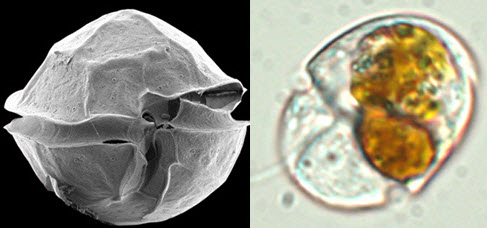
Alexandrium Pohangense (left) and Aduncodinium Glandula (right)
Professor Hae Jin JEONG’s research team (School of Earth and Environmental Sciences) discovered a new planktonic phototrophic dinoflagellate species, which it named the Alexandrium pohangense after the coastal area (Pohang) in which it was discovered. The team discovered another planktonic phototrophic dinoflagellate species in the coastal region of Masan, which it named the Aduncodinium glandula. Currently, 2,400 species of dinoflagellate have been reported worldwide. Dinoflagellate are known to prey on cochlodinum, a kind of plankton which is the main cause of red tides in the Korean peninsula. They also contain a large amount of cellular DNA, as estimates of dinoflagellate DNA content range from 3 to 250 pg/cell, corresponding to approximately 3000–215,000 Mb (the haploid human genome is 3,180 Mb, in comparison). The team found that Alexandrium pohangense performs photosynthesis but also preys on other living organisms which makes it half plant and half animal. The discoveries were published in Harmful Algae in January and July 2015, respectively.
Published in Kyunghyang Shinmun
Summary by LEE Hee Un, SNU English Editor, gurume0221@snu.ac.kr
Proofread by Melora Brett Briana Johnson, morningcalm2@gmail.com

